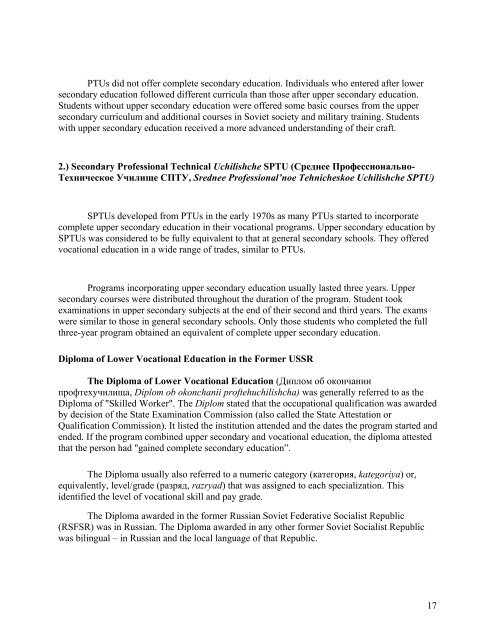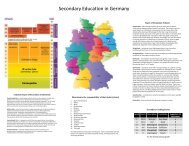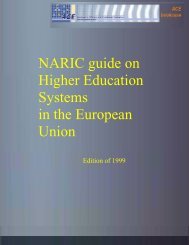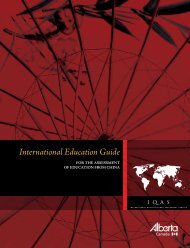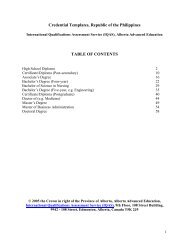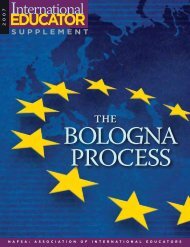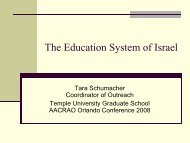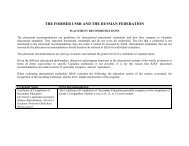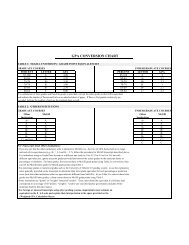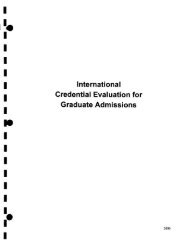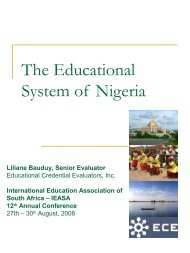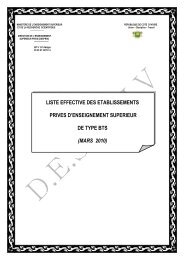Credential Templates, The Former USSR and the Russian Federation
Credential Templates, The Former USSR and the Russian Federation
Credential Templates, The Former USSR and the Russian Federation
Create successful ePaper yourself
Turn your PDF publications into a flip-book with our unique Google optimized e-Paper software.
PTUs did not offer complete secondary education. Individuals who entered after lower<br />
secondary education followed different curricula than those after upper secondary education.<br />
Students without upper secondary education were offered some basic courses from <strong>the</strong> upper<br />
secondary curriculum <strong>and</strong> additional courses in Soviet society <strong>and</strong> military training. Students<br />
with upper secondary education received a more advanced underst<strong>and</strong>ing of <strong>the</strong>ir craft.<br />
2.) Secondary Professional Technical Uchilishche SPTU (Среднее Профессионально-<br />
Техническое Училище СПТУ, Srednee Professional’noe Tehnicheskoe Uchilishche SPTU)<br />
SPTUs developed from PTUs in <strong>the</strong> early 1970s as many PTUs started to incorporate<br />
complete upper secondary education in <strong>the</strong>ir vocational programs. Upper secondary education by<br />
SPTUs was considered to be fully equivalent to that at general secondary schools. <strong>The</strong>y offered<br />
vocational education in a wide range of trades, similar to PTUs.<br />
Programs incorporating upper secondary education usually lasted three years. Upper<br />
secondary courses were distributed throughout <strong>the</strong> duration of <strong>the</strong> program. Student took<br />
examinations in upper secondary subjects at <strong>the</strong> end of <strong>the</strong>ir second <strong>and</strong> third years. <strong>The</strong> exams<br />
were similar to those in general secondary schools. Only those students who completed <strong>the</strong> full<br />
three-year program obtained an equivalent of complete upper secondary education.<br />
Diploma of Lower Vocational Education in <strong>the</strong> <strong>Former</strong> <strong>USSR</strong><br />
<strong>The</strong> Diploma of Lower Vocational Education (Диплом об окончании<br />
профтехучилища, Diplom ob okonchanii proftehuchilishcha) was generally referred to as <strong>the</strong><br />
Diploma of "Skilled Worker". <strong>The</strong> Diplom stated that <strong>the</strong> occupational qualification was awarded<br />
by decision of <strong>the</strong> State Examination Commission (also called <strong>the</strong> State Attestation or<br />
Qualification Commission). It listed <strong>the</strong> institution attended <strong>and</strong> <strong>the</strong> dates <strong>the</strong> program started <strong>and</strong><br />
ended. If <strong>the</strong> program combined upper secondary <strong>and</strong> vocational education, <strong>the</strong> diploma attested<br />
that <strong>the</strong> person had "gained complete secondary education”.<br />
<strong>The</strong> Diploma usually also referred to a numeric category (категория, kategoriya) or,<br />
equivalently, level/grade (разряд, razryad) that was assigned to each specialization. This<br />
identified <strong>the</strong> level of vocational skill <strong>and</strong> pay grade.<br />
<strong>The</strong> Diploma awarded in <strong>the</strong> former <strong>Russian</strong> Soviet Federative Socialist Republic<br />
(RSFSR) was in <strong>Russian</strong>. <strong>The</strong> Diploma awarded in any o<strong>the</strong>r former Soviet Socialist Republic<br />
was bilingual – in <strong>Russian</strong> <strong>and</strong> <strong>the</strong> local language of that Republic.<br />
17


